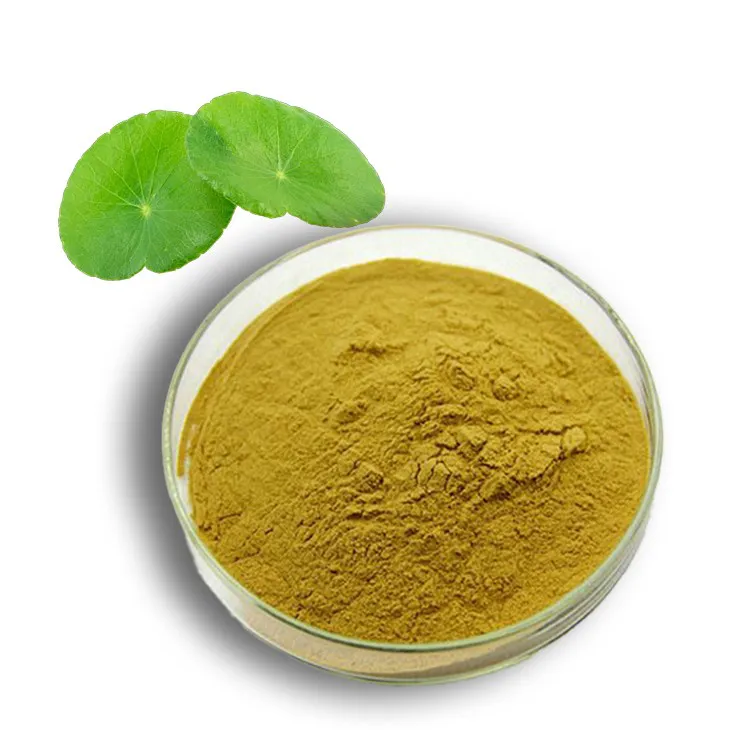- 0086-571-85302990
- sales@greenskybio.com
Does Centella asiatica extract have benefits for diabetes? Are these all safe and applicable for diabetic patients?
2024-11-14

1. Introduction
Diabetes mellitus is a chronic metabolic disorder that has reached epidemic proportions globally. It is characterized by high blood glucose levels due to either insufficient insulin production or ineffective insulin action. Management of diabetes often involves a combination of lifestyle modifications, medications, and sometimes, the use of natural supplements. Centella asiatica, also known as Gotu Kola, is a herbaceous plant that has been used in traditional medicine for centuries. In recent years, there has been growing interest in exploring the potential benefits of Centella Asiatica Extract for diabetes management. However, questions regarding its safety and applicability for diabetic patients remain.

2. The Composition of Centella Asiatica Extract
Centella Asiatica Extract contains a variety of bioactive compounds. Some of the major components include:
- Triterpenoids: Such as asiaticoside, madecassoside, and asiatic acid. These triterpenoids are believed to be responsible for many of the plant's medicinal properties.
- Flavonoids: Which have antioxidant properties and may play a role in various physiological processes.
- Polyphenols: They also contribute to the antioxidant activity of the extract.

3. Potential Benefits for Diabetes
3.1 Influence on Insulin Function
One of the key aspects in diabetes management is insulin function. There is evidence to suggest that Centella asiatica extract may have a positive impact on insulin. Some studies have shown that certain compounds in the extract may enhance insulin sensitivity. For example, the triterpenoids present in Centella asiatica might interact with insulin signaling pathways in cells. This interaction could potentially lead to better glucose uptake by cells, which is crucial for maintaining normal blood glucose levels. When cells become more sensitive to insulin, the body can use glucose more effectively, reducing hyperglycemia.
3.2 Anti - Inflammatory Effects
Diabetes is often associated with chronic inflammation. Centella asiatica extract has well - known anti - inflammatory properties. Chronic inflammation in diabetes can contribute to insulin resistance and various complications. By reducing inflammation, the extract may help to improve insulin sensitivity. The anti - inflammatory action may be mediated through the modulation of cytokines and other inflammatory mediators. For instance, it can suppress the production of pro - inflammatory cytokines such as TNF - α and IL - 6, which are often elevated in diabetic patients. This reduction in inflammation can have a positive impact on overall glycemic control.
3.3 Antioxidant Activity
Oxidative stress is another significant factor in diabetes. High blood glucose levels can lead to increased production of reactive oxygen species (ROS), which can damage cells and tissues. The antioxidant compounds in Centella asiatica extract, such as flavonoids and polyphenols, can scavenge ROS. By reducing oxidative stress, the extract may protect pancreatic beta - cells, which are responsible for insulin production. Protecting these cells is essential for maintaining normal insulin levels. Moreover, antioxidant activity can also help in preventing or delaying the development of diabetic complications such as neuropathy, retinopathy, and nephropathy.

4. Safety Considerations for Diabetic Patients
4.1 General Safety Profile
Centella asiatica extract is generally considered safe when used in appropriate doses. In traditional medicine, it has been used for a long time without major reports of severe adverse effects. However, like any supplement, there are some potential side effects. Mild gastrointestinal discomfort, such as nausea, diarrhea, or abdominal pain, may occur in some individuals. These side effects are usually transient and may subside as the body adjusts to the supplement.
4.2 Drug Interactions
Diabetic patients are often on multiple medications. It is important to consider potential drug - drug interactions when using Centella asiatica extract. For example, some studies suggest that it may interact with anticoagulant medications. Since diabetic patients are at a higher risk of cardiovascular diseases and may be taking anticoagulants, this interaction needs to be carefully evaluated. There may also be interactions with medications used for glycemic control. Although the exact nature of these interactions is not fully understood, it is advisable for diabetic patients to consult their healthcare providers before starting to use Centella asiatica extract.
4.3 Long - Term Safety
While short - term use of Centella asiatica extract appears to be relatively safe, the long - term safety in diabetic patients is still an area of research. Long - term use may potentially lead to cumulative effects, both positive and negative. For example, continuous exposure to certain compounds in the extract may have unforeseen effects on the liver or kidneys over time. Also, its impact on the progression of diabetes and the development of complications in the long - run needs further investigation.
5. Clinical Evidence
Although there are some pre - clinical studies suggesting the potential benefits of Centella asiatica extract for diabetes, the clinical evidence is still limited. Some small - scale human studies have reported positive effects on glycemic control, but larger and more comprehensive clinical trials are needed to confirm these findings. For example, a pilot study may have shown a reduction in fasting blood glucose levels in a group of diabetic patients taking Centella asiatica extract, but the study may have had limitations in terms of sample size, study duration, and lack of a proper control group. More well - designed clinical trials should be carried out to evaluate the effectiveness and safety of the extract in diabetic patients.
6. Dosage and Administration
There is no standardized dosage of Centella asiatica extract for diabetes management. In general, the dosage used in studies varies depending on the form of the extract (e.g., powder, tincture, capsule) and the specific study design. When considering using the extract, it is important to follow the manufacturer's instructions. However, it is also crucial for diabetic patients to consult their healthcare providers, as the appropriate dosage may need to be adjusted based on individual factors such as age, body weight, overall health status, and the presence of other medical conditions or medications.
7. Conclusion
Centella asiatica extract shows potential benefits for diabetes management through its influence on insulin function, anti - inflammatory, and antioxidant effects. However, the safety of its use in diabetic patients, especially in terms of long - term use and potential drug interactions, requires further investigation. While the existing evidence is promising, more comprehensive clinical trials are needed to establish its effectiveness and safety. Diabetic patients should always consult their healthcare providers before using Centella asiatica extract as a complementary approach to diabetes management.
FAQ:
Question 1: How does Centella asiatica extract affect blood sugar levels in diabetic patients?
Centella asiatica extract may have potential effects on blood sugar levels through various mechanisms. Some studies suggest that it could enhance insulin sensitivity, which means cells in the body can respond better to insulin. Insulin is crucial for transporting glucose from the bloodstream into cells, where it can be used for energy or stored. By improving insulin sensitivity, the extract may help in reducing elevated blood sugar levels in diabetic patients. However, more research is still needed to fully understand the extent and consistency of this effect.
Question 2: Can Centella asiatica extract replace diabetes medications?
As of now, Centella asiatica extract cannot replace diabetes medications. Diabetes medications are specifically designed and clinically tested to manage blood sugar levels in different ways, such as increasing insulin production, improving insulin action, or reducing glucose absorption in the gut. While Centella asiatica extract may show some beneficial effects on blood sugar, it has not been proven to be as effective or reliable as established diabetes medications. Diabetic patients should always consult their healthcare providers before making any changes to their medication regimens.
Question 3: Are there any side effects of Centella asiatica extract for diabetic patients?
Although Centella asiatica extract is generally considered safe for most people, some potential side effects may occur. In diabetic patients, it could potentially interact with other medications they are taking. For example, it may interfere with the absorption or effectiveness of certain drugs. Additionally, some individuals may experience allergic reactions to the extract. Common side effects in non - diabetic individuals using Centella asiatica extract may include gastrointestinal discomfort such as nausea, vomiting, or diarrhea, but it's not clear if these are more or less likely to occur in diabetic patients. More research is required to determine the specific side - effect profile in diabetic patients.
Question 4: How does Centella asiatica extract influence insulin function?
Centella asiatica extract may influence insulin function by several means. It might help in protecting pancreatic beta - cells, which are responsible for insulin production. By reducing oxidative stress and inflammation in the pancreas, the extract could potentially prevent damage to these cells, ensuring a more stable insulin production. Moreover, as mentioned earlier, it could enhance insulin sensitivity in peripheral tissues like muscle, fat, and liver cells. This allows these cells to more effectively take up glucose in response to insulin, which is important for maintaining normal blood sugar levels.
Question 5: What are the long - term implications of using Centella asiatica extract for diabetic patients?
The long - term implications of using Centella asiatica extract for diabetic patients are still not fully understood. While short - term studies may show some positive effects on blood sugar control and related factors, long - term use could potentially have unforeseen consequences. For example, there could be cumulative effects on the body's metabolism or interactions with other health conditions that may develop over time. Also, the body may develop tolerance or adaptation to the extract, which could affect its efficacy. Continued research is essential to determine the long - term safety and effectiveness of Centella asiatica extract for diabetic patients.
Related literature
- Centella asiatica in Diabetes Mellitus: A Review of Potential Mechanisms and Therapeutic Applications"
- "The Impact of Herbal Extracts, including Centella asiatica, on Diabetes Management: Current Evidence and Future Perspectives"
- "Centella asiatica and Insulin Sensitivity: Insights from Preclinical Studies"
- ▶ Hesperidin
- ▶ citrus bioflavonoids
- ▶ plant extract
- ▶ lycopene
- ▶ Diosmin
- ▶ Grape seed extract
- ▶ Sea buckthorn Juice Powder
- ▶ Beetroot powder
- ▶ Hops Extract
- ▶ Artichoke Extract
- ▶ Reishi mushroom extract
- ▶ Astaxanthin
- ▶ Green Tea Extract
- ▶ Curcumin Extract
- ▶ Horse Chestnut Extract
- ▶ Other Problems
- ▶ Boswellia Serrata Extract
- ▶ Resveratrol Extract
- ▶ Marigold Extract
- ▶ Grape Leaf Extract
- ▶ blog3
- ▶ blog4
- ▶ blog5
-
Organic Tongkat Ali extract powder factory.
2024-11-14
-
How to make powder with ashwagandha extract.
2024-11-14
-
Rosehip extract manufacturers from China.
2024-11-14
-
The best cat's claw extract in nature.
2024-11-14
-
Chinese Dandelion Leaf Extract Suppliers.
2024-11-14
-
Chia Seed Powder
2024-11-14
-
Hedyotis Diffusa Extract
2024-11-14
-
Licorice Root Extract Powder
2024-11-14
-
Bayberry Extract
2024-11-14
-
Sea buckthorn Juice Powder
2024-11-14
-
Golden Seal Extract
2024-11-14
-
Ivy Extract
2024-11-14
-
Sea buckthorn oil
2024-11-14
-
Europen Bilberry Extract
2024-11-14
-
Citrus bioflavonoids
2024-11-14





















